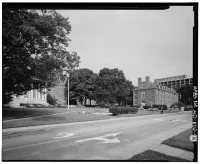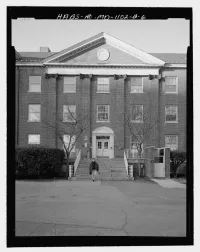Share what you know,
and discover more.
Share what you know,
and discover more.

-

- Marley Zielike
National Institutes of Health, 9000 Rockville Pike, Bethesda, Montgomery County, MD
Begun as a one-room laboratory in 1887, the National Institutes of Health (NIH), an agency of the United States Department of Health and Human Services, today is one of the world`s foremost biomedical research centers and the world`s single largest supporter of biomedical research. Since 1938, the headquarters of NIH has been in Bethesda, Maryland. The core of the site was donated by Helen and Luke I. Wilson in 1935. Since its establishment, the Bethesda campus has been the location of an extraordinary quantity of basic and clinical medical research. As the administrative center for NIH, it is also the center of the remarkable extramural program that has supported a significant portion of the nation`s medical research. Specific medical advancements attributable to NIH`s programs include the prizewinning work of 90 Nobel laureates through the extramural program and the work of five Nobel laureates through its intramural program.
National Institutes of Health, 9000 Rockville Pike, Bethesda, Montgomery County, MD
Begun as a one-room laboratory in 1887, the National Institutes of Health (NIH), an agency of the United States Department of Health and Human Services, today is one of the world`s foremost biomedical research centers and the world`s single largest supporter of biomedical research. Since 1938, the headquarters of NIH has been in Bethesda, Maryland. The core of the site was donated by Helen and Luke I. Wilson in 1935. Since its establishment, the Bethesda campus has been the location of an extraordinary quantity of basic and clinical medical research. As the administrative center for NIH, it is also the center of the remarkable extramural program that has supported a significant portion of the nation`s medical research. Specific medical advancements attributable to NIH`s programs include the prizewinning work of 90 Nobel laureates through the extramural program and the work of five Nobel laureates through its intramural program.
National Institutes of Health, 9000 Rockville Pike, Bethesda, Montgomery County, MD
Begun as a one-room laboratory in 1887, the National Institutes of Health (NIH), an agency of the United States Department of Health and Human Services, today is one of the world`s foremost biomedical research centers and the world`s single largest supporter of biomedical research. Since 1938, the headquarters of NIH has been in Bethesda, Maryland. The core of the site was donated by Helen and Luke I. Wilson in 1935. Since its establishment, the Bethesda campus has been the location of an extraordinary quantity of basic and clinical medical research. As the administrative center for NIH, it is also the center of the remarkable extramural program that has supported a significant portion of the nation`s medical research. Specific medical advancements attributable to NIH`s programs include the prizewinning work of 90 Nobel laureates through the extramural program and the work of five Nobel laureates through its intramural program.Posted Date
Sep 28, 2021
Source Name
Library of Congress
Source Website
Delete Story
Are you sure you want to delete this story?

-

- Marley Zielike
National Institutes of Health, Industrial Hygiene Laboratory, 9000 Rockville Pike, Bethesda, Montgomery County, MD
The Industrial Hygeine Laboratory, constructed in 1938, is one of the original laboratory buildings built for the National Institute of Health (NIH) in Bethesda, and the first laboratory built solely for the study of industrial hygiene in the nation. The Georgian Revival building is one of a set of buildings built to serve as the nucleus for the national research center. The other two buildings constructed in 1938 were the Administration Building (Building 1) and the Public Health Methods & Animal Unit Building (Building 3). Planned around a central, landscaped square, the Administration Building was flanked to the northeast by the Industrial Hygiene Laboratory and to the southeast by the Public Health Methods & Animal Unit Building. As one of the three earliest buildings erected on the NIH campus, Building 2 contributes to the early history of the institution as a center for the study of disease. The Division of Industrial Hygiene of the United States Public Health Service was concerned primarily with maintaining the health of industrial workers across the country, and investigating the causes and effects of occupational accidents and diseases. The research conducted by NIH scientists in the Industrial Hygiene Laboratory produced dramatic improvements in working conditions and in the overall health of the civil population. These developments proved crucial to meeting the challenge of keeping the American people healthy during World War II, preventing disease, and providing military personnel with the finest medical care in history.
National Institutes of Health, Industrial Hygiene Laboratory, 9000 Rockville Pike, Bethesda, Montgomery County, MD
The Industrial Hygeine Laboratory, constructed in 1938, is one of the original laboratory buildings built for the National Institute of Health (NIH) in Bethesda, and the first laboratory built solely for the study of industrial hygiene in the nation. The Georgian Revival building is one of a set of buildings built to serve as the nucleus for the national research center. The other two buildings constructed in 1938 were the Administration Building (Building 1) and the Public Health Methods & Animal Unit Building (Building 3). Planned around a central, landscaped square, the Administration Building was flanked to the northeast by the Industrial Hygiene Laboratory and to the southeast by the Public Health Methods & Animal Unit Building. As one of the three earliest buildings erected on the NIH campus, Building 2 contributes to the early history of the institution as a center for the study of disease. The Division of Industrial Hygiene of the United States Public Health Service was concerned primarily with maintaining the health of industrial workers across the country, and investigating the causes and effects of occupational accidents and diseases. The research conducted by NIH scientists in the Industrial Hygiene Laboratory produced dramatic improvements in working conditions and in the overall health of the civil population. These developments proved crucial to meeting the challenge of keeping the American people healthy during World War II, preventing disease, and providing military personnel with the finest medical care in history.
National Institutes of Health, Industrial Hygiene Laboratory, 9000 Rockville Pike, Bethesda, Montgomery County, MD
The Industrial Hygeine Laboratory, constructed in 1938, is one of the original laboratory buildings built for the National Institute of Health (NIH) in Bethesda, and the first laboratory built solely for the study of industrial hygiene in the nation. The Georgian Revival building is one of a set of buildings built to serve as the nucleus for the national research center. The other two buildings constructed in 1938 were the Administration Building (Building 1) and the Public Health Methods & Animal Unit Building (Building 3). Planned around a central, landscaped square, the Administration Building was flanked to the northeast by the Industrial Hygiene Laboratory and to the southeast by the Public Health Methods & Animal Unit Building. As one of the three earliest buildings erected on the NIH campus, Building 2 contributes to the early history of the institution as a center for the study of disease. The Division of Industrial Hygiene of the United States Public Health Service was concerned primarily with maintaining the health of industrial workers across the country, and investigating the causes and effects of occupational accidents and diseases. The research conducted by NIH scientists in the Industrial Hygiene Laboratory produced dramatic improvements in working conditions and in the overall health of the civil population. These developments proved crucial to meeting the challenge of keeping the American people healthy during World War II, preventing disease, and providing military personnel with the finest medical care in history.Posted Date
Sep 28, 2021
Source Name
Library of Congress
Source Website
Delete Story
Are you sure you want to delete this story?

-

- Marley Zielike
National Institutes of Health, National Cancer Institute, 9000 Rockville Pike, Bethesda, Montgomery County, MD
Building 6 was constructed in 1939 specifically to house the newly established National Cancer Institute (NCI), the very first institute of the federal research center referred to at the time as the National Institute of Health (NIH). The NCI was created through the National Cancer Institute Act, approved by Congress on July 23, 1937, and signed into law by President Franklin Delano Roosevelt on August 5, 1937. The mission of the new NCI, as stated in the Act (P.L. No. 244) was to "conduct research, investigations, experiments, and studies relating to the cause, diagnosis, and treatment of cancer; assist and foster similar research activities by other agencies, public and private; and promote the coordination of all such researches and activities and the useful application of their results." The NCI would assist in the development and widespread use of the most effective methods of prevention, diagnosis, and treatment of cancer on both a national and international level. Creation of the NCI was significant to the overall history of NIH as its principles set forth the authorization of other research-specific institutes, leading eventually to the collective formation of the National Institutes of Health in 1948. Building 6 was the fourth building authorized for construction by the Public Health Service at the new NIH Bethesda site. The research conducted within this facility led to advancements in the early detection of cancer, methods for eradicating cancer cells through chemotherapy and radiation, improving environmental conditions to control preventable cancers, and identifying genetic factors that can determine the likelihood of developing this disease. The work conducted by the National Cancer Institute was instrumental in the establishment of the 1971 National Cancer Act, a $1.6 billion federal crusade against cancer. The NCI and the National Cancer Act provision can claim responsibility for reducing the incidence, suffering, and death from cancer across the nation and worldwide.
National Institutes of Health, National Cancer Institute, 9000 Rockville Pike, Bethesda, Montgomery County, MD
Building 6 was constructed in 1939 specifically to house the newly established National Cancer Institute (NCI), the very first institute of the federal research center referred to at the time as the National Institute of Health (NIH). The NCI was created through the National Cancer Institute Act, approved by Congress on July 23, 1937, and signed into law by President Franklin Delano Roosevelt on August 5, 1937. The mission of the new NCI, as stated in the Act (P.L. No. 244) was to "conduct research, investigations, experiments, and studies relating to the cause, diagnosis, and treatment of cancer; assist and foster similar research activities by other agencies, public and private; and promote the coordination of all such researches and activities and the useful application of their results." The NCI would assist in the development and widespread use of the most effective methods of prevention, diagnosis, and treatment of cancer on both a national and international level. Creation of the NCI was significant to the overall history of NIH as its principles set forth the authorization of other research-specific institutes, leading eventually to the collective formation of the National Institutes of Health in 1948. Building 6 was the fourth building authorized for construction by the Public Health Service at the new NIH Bethesda site. The research conducted within this facility led to advancements in the early detection of cancer, methods for eradicating cancer cells through chemotherapy and radiation, improving environmental conditions to control preventable cancers, and identifying genetic factors that can determine the likelihood of developing this disease. The work conducted by the National Cancer Institute was instrumental in the establishment of the 1971 National Cancer Act, a $1.6 billion federal crusade against cancer. The NCI and the National Cancer Act provision can claim responsibility for reducing the incidence, suffering, and death from cancer across the nation and worldwide.
National Institutes of Health, National Cancer Institute, 9000 Rockville Pike, Bethesda, Montgomery County, MD
Building 6 was constructed in 1939 specifically to house the newly established National Cancer Institute (NCI), the very first institute of the federal research center referred to at the time as the National Institute of Health (NIH). The NCI was created through the National Cancer Institute Act, approved by Congress on July 23, 1937, and signed into law by President Franklin Delano Roosevelt on August 5, 1937. The mission of the new NCI, as stated in the Act (P.L. No. 244) was to "conduct research, investigations, experiments, and studies relating to the cause, diagnosis, and treatment of cancer; assist and foster similar research activities by other agencies, public and private; and promote the coordination of all such researches and activities and the useful application of their results." The NCI would assist in the development and widespread use of the most effective methods of prevention, diagnosis, and treatment of cancer on both a national and international level. Creation of the NCI was significant to the overall history of NIH as its principles set forth the authorization of other research-specific institutes, leading eventually to the collective formation of the National Institutes of Health in 1948. Building 6 was the fourth building authorized for construction by the Public Health Service at the new NIH Bethesda site. The research conducted within this facility led to advancements in the early detection of cancer, methods for eradicating cancer cells through chemotherapy and radiation, improving environmental conditions to control preventable cancers, and identifying genetic factors that can determine the likelihood of developing this disease. The work conducted by the National Cancer Institute was instrumental in the establishment of the 1971 National Cancer Act, a $1.6 billion federal crusade against cancer. The NCI and the National Cancer Act provision can claim responsibility for reducing the incidence, suffering, and death from cancer across the nation and worldwide.Posted Date
Sep 28, 2021
Source Name
Library of Congress
Source Website
Delete Story
Are you sure you want to delete this story?




